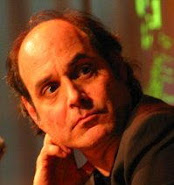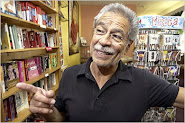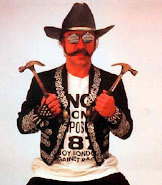
Latino Genius: Baldemar Velazquez
(Farm Labor Leader)
Lesson plans created by Irma Vargas Rosas, M.A., M.Ed, doctoral student
Program in Culture, Literacy, and Language
Division of Bilingual Bicultural Studies
University of Texas, San Antonio
University of Texas, San Antonio
Lesson Plan Title – Critical Evaluation, Writing & Art
Learning Level
Grades 6-12
Pre-Instruction or Prerequisite Knowledge/Skills
Basic critical analysis, writing, and art skills
Lesson Duration
4-5 sessions, 1-2 hours each
Students may choose to do research outside of class.
Learning Location
Computer lab and/or classroom
Materials
Can of Campbell’s Vegetable Soup, chart paper, Jar of Vlasic Pickles, Computers with Internet connection and printer/paper, poster boards, markers, arts&crafts material
Learning Level
Grades 6-12
Pre-Instruction or Prerequisite Knowledge/Skills
Basic critical analysis, writing, and art skills
Lesson Duration
4-5 sessions, 1-2 hours each
Students may choose to do research outside of class.
Learning Location
Computer lab and/or classroom
Materials
Can of Campbell’s Vegetable Soup, chart paper, Jar of Vlasic Pickles, Computers with Internet connection and printer/paper, poster boards, markers, arts&crafts material
Powerpoint available: [Coming soon]
Learning Objectives (Teacher may wish to modify them as she/he deems necessary: http://www.tea.state.tx.us/teks/)
Grades 6-8
English Language Arts/Reading
TEKS 15B: The student is expected to write to influence such as to persuade, argue, and
request.
15F: The student is expected to compare text events with his/her own and other readers’ experiences.
14A: The student is expected to generate ideas and plans for writing.
Fine Arts (Art)
4A: The student is expected to interpret, evaluate, and justify artistic decisions in personal artworks.
2C: The student is expected to demonstrate technical skills effectively, using a variety of art media and materials to produce designs, drawings, paintings, prints, sculptures, ceramics, fiberart, photographic imagery, and electronic media-generated art.
Grades 9-12
English Language Arts/Reading
9B: The student is expected to compare text events with his/her own and other readers' experiences.
Fine Arts (Art)
4A: The student is expected to interpret, evaluate, and justify artistic decisions in personal artworks.
2C: The student is expected to demonstrate technical skills effectively, using a variety of art media and materials to produce designs, drawings, paintings, prints, sculptures, ceramics, fiberart, photographic imagery, and electronic media-generated art.
Procedure
1.) Before mentioning Baldemar Velazquez and who he is, teacher will present the can of soup and pickles to students.
2.) In groups of 4-5, students will discuss and write what they know about the two products.
3.) Teacher will write the information on chart paper.
4.) Teacher will ask: Who is a MacArthur genius?
5.) Teacher will use Internet site to discuss the MacArthur Foundation and Fellows (geniuses). www.macfound.org/programs/fel/fel_overview.htm
6.) Teacher will inform students that Baldemar Velazquez is a MacArthur genius.
7.) Teacher will say: the can of soup and jar of pickles are a few of the reasons why Baldemar Velazquez is a genius.
8.) Students will investigate the life and successes of Baldemar Velazquez (Google Scholar, Google, etc.) by focusing on the 5Ws and How. http://en.wikipedia.org/wiki/Five_Ws
Sample Questions: Who is Baldemar Velazquez?; Where does he live or work?; What does he do?; How does he make a difference in the community?; When did he get the MacArthur Fellowship?; Why did he get the fellowship?
9.) Students discuss their research findings on Baldemar Velasquez and teacher will list them on chart paper (5Ws and H). The following is some information regarding Baldemar Velazquez that the teacher may use:
Baldemar Velasquez, human rights activist and founder and president of the Farm Labor Organizing Committee (FLOC) AFL-CIO, was born in Pharr, Texas Feb. 15, 1947. His parents were migrant farmworkers, and Velasquez began working in the fields when he was six, picking berries and tomatoes.He attended Pan American University in Edinburg, Texas from 1965-66. Ohio Northern University in Ada 1966-67 and from 1967-69 attended Bluffton College, where he graduated with a BA in Sociology. He formed Farm Labor Organizing Committee (FLOC) in 1967. During 1989-90, Velasquez received his degree in Practical Theology. He received his advanced degree in 1991 and was ordained that year as Chaplain to the farmworkers by Rapha Ministries. Two major honors came to Velasquez in 1994 when 29 national Hispanic organizations chose him as the recipient of the Hispanic Heritage Leadership Award. That year he also received Mexico's Aguila Azteca Award - the highest award Mexico can give a non-citizen.
10.) Teacher will review concepts ‘human rights’ and ‘self-determination;’
http://www.floc.com/; http://www.m-w.com/dictionary/human%20rights;
http://www.m-w.com/dictionary/self-determination
11.) Students will research current events of human rights’ abuse for farm laborers.
12.) Students will select two causes/missions for farm laborers’ rights, one at the state level (Texas or any other state or Puerto Rico) and the other at the national level. Teacher may wish to focus only on one.
13.) Students will write a letter to each of the causes using a persuasive essay in letter format: http://grants.coehd.utsa.edu/ATE/support/Latino_Genius/Rubric_Letter_Writing.pdf; http://grants.coehd.utsa.edu/ATE/support/Latino_Genius/Rubric_Escribir_una_carta.pdf;
Learning Objectives (Teacher may wish to modify them as she/he deems necessary: http://www.tea.state.tx.us/teks/)
Grades 6-8
English Language Arts/Reading
TEKS 15B: The student is expected to write to influence such as to persuade, argue, and
request.
15F: The student is expected to compare text events with his/her own and other readers’ experiences.
14A: The student is expected to generate ideas and plans for writing.
Fine Arts (Art)
4A: The student is expected to interpret, evaluate, and justify artistic decisions in personal artworks.
2C: The student is expected to demonstrate technical skills effectively, using a variety of art media and materials to produce designs, drawings, paintings, prints, sculptures, ceramics, fiberart, photographic imagery, and electronic media-generated art.
Grades 9-12
English Language Arts/Reading
9B: The student is expected to compare text events with his/her own and other readers' experiences.
Fine Arts (Art)
4A: The student is expected to interpret, evaluate, and justify artistic decisions in personal artworks.
2C: The student is expected to demonstrate technical skills effectively, using a variety of art media and materials to produce designs, drawings, paintings, prints, sculptures, ceramics, fiberart, photographic imagery, and electronic media-generated art.
Procedure
1.) Before mentioning Baldemar Velazquez and who he is, teacher will present the can of soup and pickles to students.
2.) In groups of 4-5, students will discuss and write what they know about the two products.
3.) Teacher will write the information on chart paper.
4.) Teacher will ask: Who is a MacArthur genius?
5.) Teacher will use Internet site to discuss the MacArthur Foundation and Fellows (geniuses). www.macfound.org/programs/fel/fel_overview.htm
6.) Teacher will inform students that Baldemar Velazquez is a MacArthur genius.
7.) Teacher will say: the can of soup and jar of pickles are a few of the reasons why Baldemar Velazquez is a genius.
8.) Students will investigate the life and successes of Baldemar Velazquez (Google Scholar, Google, etc.) by focusing on the 5Ws and How. http://en.wikipedia.org/wiki/Five_Ws
Sample Questions: Who is Baldemar Velazquez?; Where does he live or work?; What does he do?; How does he make a difference in the community?; When did he get the MacArthur Fellowship?; Why did he get the fellowship?
9.) Students discuss their research findings on Baldemar Velasquez and teacher will list them on chart paper (5Ws and H). The following is some information regarding Baldemar Velazquez that the teacher may use:
Baldemar Velasquez, human rights activist and founder and president of the Farm Labor Organizing Committee (FLOC) AFL-CIO, was born in Pharr, Texas Feb. 15, 1947. His parents were migrant farmworkers, and Velasquez began working in the fields when he was six, picking berries and tomatoes.He attended Pan American University in Edinburg, Texas from 1965-66. Ohio Northern University in Ada 1966-67 and from 1967-69 attended Bluffton College, where he graduated with a BA in Sociology. He formed Farm Labor Organizing Committee (FLOC) in 1967. During 1989-90, Velasquez received his degree in Practical Theology. He received his advanced degree in 1991 and was ordained that year as Chaplain to the farmworkers by Rapha Ministries. Two major honors came to Velasquez in 1994 when 29 national Hispanic organizations chose him as the recipient of the Hispanic Heritage Leadership Award. That year he also received Mexico's Aguila Azteca Award - the highest award Mexico can give a non-citizen.
10.) Teacher will review concepts ‘human rights’ and ‘self-determination;’
http://www.floc.com/; http://www.m-w.com/dictionary/human%20rights;
http://www.m-w.com/dictionary/self-determination
11.) Students will research current events of human rights’ abuse for farm laborers.
12.) Students will select two causes/missions for farm laborers’ rights, one at the state level (Texas or any other state or Puerto Rico) and the other at the national level. Teacher may wish to focus only on one.
13.) Students will write a letter to each of the causes using a persuasive essay in letter format: http://grants.coehd.utsa.edu/ATE/support/Latino_Genius/Rubric_Letter_Writing.pdf; http://grants.coehd.utsa.edu/ATE/support/Latino_Genius/Rubric_Escribir_una_carta.pdf;
http://grants.coehd.utsa.edu/ATE/support/Latino_Genius/Rubric_Escrito_persuasivo.pdf Teacher may wish to make extra copies.
14.) Students will create posters for their causes. Students may wish to use them in a political demonstration, display them in the classroom, hallway or entry way to the school.
15.) Teacher will conclude the lessons by engaging students in conversation using the following two questions:
· Who is a genius?
· How have the experiences gained through these activities made you think about your future?
Evaluation
The teacher may use the rubrics to assess students or other forms as she/he deems appropriate.
About the Author
14.) Students will create posters for their causes. Students may wish to use them in a political demonstration, display them in the classroom, hallway or entry way to the school.
15.) Teacher will conclude the lessons by engaging students in conversation using the following two questions:
· Who is a genius?
· How have the experiences gained through these activities made you think about your future?
Evaluation
The teacher may use the rubrics to assess students or other forms as she/he deems appropriate.
About the Author
Irma Vargas Rosas is first generation Chicana, born and raised in Chicago, IL. She has three degrees from the University of IL, Chicago. She obtained a B.A. in Political Science and Spanish in 1996. Then she continued and obtained two masters degrees: an M.A. in Hispanic Studies specializing in Applied Linguistics in 1998 and M.Ed. specializing in Bilingual Education in 2003. She was a classroom teacher for several years in Chicago and San Antonio, Texas and has experience in dual language, transitional bilingual, and ESL programs. She is currently a doctoral student in the College of Education and Human Development at the University of Texas, San Antonio. She currently lives in San Antonio with her partner Rita and their two perritos Corbatín and Lalito.






No comments:
Post a Comment